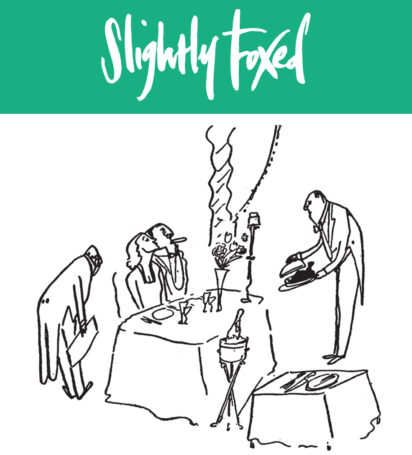‘I have written a book which gives me much pleasure. It is a kind of full-length portrait of a small country town between the wars. The sort of life that will never come back,’ John Moore wrote to T. H. White in the summer of 1945.
The book was Portrait of Elmbury, the first volume in a trilogy based on Moore’s home town. Born in 1907, he grew up in Tewkesbury at a time when such small English market towns still had a distinct and sturdy life of their own. Mass travel, mass media and the changes brought about by two world wars would gradually destroy this self-contained rural society, but in this book Moore caught and preserved it in captivating detail.
Portrait is by no means sentimental. Moore’s family home, ‘the loveliest house in Elmbury . . . looked across a wide main street upon the filthiest slum I have ever set eyes on’. This was Double Alley, whose wild and drunken inhabitants were part of Moore’s growing-up, as were a large cast of rugged individuals including his schoolmaster Mr Chorlton, who taught him about Greek verse and Lepidoptera; the duck-shooting, whisky-drinking local colonel with his ‘badger-grizzled walrus moustache’ and pulsating red nose; and Miss Benedict, the disapproving barmaid at one of the town’s 28 pubs.
Though it may be unsentimental, Moore’s picture of Elmbury, with its surrounding farms and orchards, its river meadows and great Romanesque abbey, is a joyful hymn to the fullness and variety of small-town life. Moore later became a journalist, wrote many books and spent some time in London, where he found the inhabitants of Bloomsbury ‘as conventional as the heroes and heroines of their novels’. But he always returned to Tewkesbury, where somehow ‘emotions seemed larger, pleasures were keener, sorrows sharper, the tragedy more profound and the comedy more riotous’. In Portrait of Elmbury he left a wonderful account of that vanished world – of a ‘life that will never come back’.
‘One of the best known and loved writers about the countryside in the twentieth century’ Sir Compton Mackenzie
A New England: Tewkesbury
Once in a while, a special book reaches out through the wisps of time and demands to be read. John Moore’s Portrait of Elmbury was written in 1945 and recalls his corner of England during the first...
Read moreThere was one day that fell in early December, more exciting than Christmas itself . . .
Always on this occasion my father’s firm provided sandwiches and drinks for all comers: dealers, smallholders, cowmen, shepherds, drovers. (The more substantial farmers were entertained to luncheon...
Read more‘One of the most wonderful books I’ve ever read . . .’
‘I wanted to let you know that I ordered Portrait of Elmbury based on the review and excerpts in SF. I’ve just finished it and have to say that this was one of the most wonderful books I’ve...
Read more‘Portrait of Elmbury was fun and quite vivid . . .’
‘Portrait of Elmbury was fun and quite vivid, and moving too . . .’
Read more














The latest in the independent publisher’s series of rediscovered classic memoirs is yet another literary hidden gem. This stylish, pocket-sized hardback, cloth-bound in emerald green with a silk ribbon marker, will delight book lovers before even opening it. Moore was born in 1907 and grew up in Tewkesbury, before the distinct character and way of life of small market towns was eroded by two world wars and the onslaught of mass travel and globalisation.
The first in a trilogy, this is as much a beautifully executed portrait of a time and place as a love letter to his home town. But far from rose-tinted nostalgia, the elegant phrasing, understated humour and acute observations bring back to multilayered life a vanished world, warts and all. Eccentric characters, from the amusing to the grotesque, crumbling slums and splendid buildings, hilarious anecdotes and a generation wiped out by war – all this is deftly conveyed with verve and wit. If you think small-town life is dull, this book will make you reconsider.